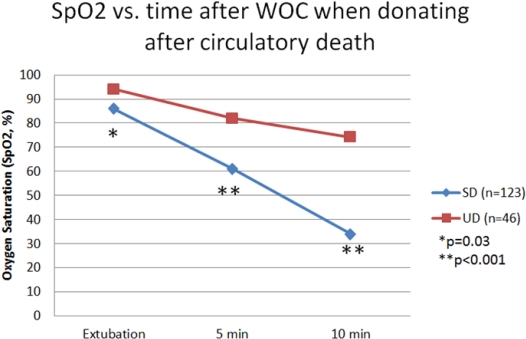When Do DCD Donors Die? Outcomes and Implications of DCD at a High-Volume, Single-Center OPO in the United States
1Division of Transplantation, Dept. of Surgery, University of Wisconsin, Madison, WI
2Organ Recovery, UW Organ and Tissue Donation, Madison, WI.
Meeting: 2015 American Transplant Congress
Abstract number: A60
Keywords: Cadaveric organs, Donation, Donors, marginal, non-heart-beating
Session Information
Session Name: Poster Session A: Donor Management: All Organs
Session Type: Poster Session
Date: Saturday, May 2, 2015
Session Time: 5:30pm-7:30pm
 Presentation Time: 5:30pm-7:30pm
Presentation Time: 5:30pm-7:30pm
Location: Exhibit Hall E
Introduction: Successful donation (SD) is not always possible following attempted donation after circulatory death (DCD). The goal of this study was to determine the fate of DCD donors who did not progress to death using a standard DCD protocol.
Methods: Data were collected for all DCD donors between 1/2011 and 8/2014. DCDs were performed using a uniform protocol at a single-center organ procurement organization (OPO). The time of withdraw-of-care (WOC), result of the attempted DCD recovery, and patient demographics were collected.
Results: During the time frame considered, DCD donation was attempted in 169 patients. Of 169 patients, 123 donated at least one organ. In 46 patients (27.2%) no organs were recovered because the patients did not expire within 2 hours. There was no difference in age, gender or race between the SD and UD groups. SD was more likely if WOC occurred in the operating room vs. the intensive care unit (p=0.006). Early decrements in oxygen saturation  correlated with SD (p<0.001). Time from extubation to death was available for 161/169 donors (95.3%). Of 161 donors, 111 (66.9%) expired in under 1 hour. The mean time from WOC to patient death for UDs was 33 hrs, 37 min. (range, 24 min.-242 hrs) vs 29 min. (range, 5 min.-2 hrs,4 min.) for SDs. Twenty-seven UDs (67.5%) expired within 24 hours. Eight UDs (15.2%) expired in greater than 48 hours. Were UD converted to SD, as many as 125 abdominal (33 liver and 92 kidney) transplants could have been performed over the study period in a single OPO.
correlated with SD (p<0.001). Time from extubation to death was available for 161/169 donors (95.3%). Of 161 donors, 111 (66.9%) expired in under 1 hour. The mean time from WOC to patient death for UDs was 33 hrs, 37 min. (range, 24 min.-242 hrs) vs 29 min. (range, 5 min.-2 hrs,4 min.) for SDs. Twenty-seven UDs (67.5%) expired within 24 hours. Eight UDs (15.2%) expired in greater than 48 hours. Were UD converted to SD, as many as 125 abdominal (33 liver and 92 kidney) transplants could have been performed over the study period in a single OPO.
Conclusions: DCD is an important form of organ donation. A large number of abdominal transplants are not possible due to unsuccessful DCD organ donation. Innovative strategies for prediction of SD may increase total organs recovered. It may be useful to explore DCD donor family satisfaction in order to identify other options for improving DCD donation.
To cite this abstract in AMA style:
Scalea J, Redfield R, Rizzari M, Bennett R, Anderson J, Anderson M, Kaufman D, Sollinger H, Fernandez L, D'Alessandro A, Mezrich J. When Do DCD Donors Die? Outcomes and Implications of DCD at a High-Volume, Single-Center OPO in the United States [abstract]. Am J Transplant. 2015; 15 (suppl 3). https://atcmeetingabstracts.com/abstract/when-do-dcd-donors-die-outcomes-and-implications-of-dcd-at-a-high-volume-single-center-opo-in-the-united-states/. Accessed December 19, 2025.« Back to 2015 American Transplant Congress
